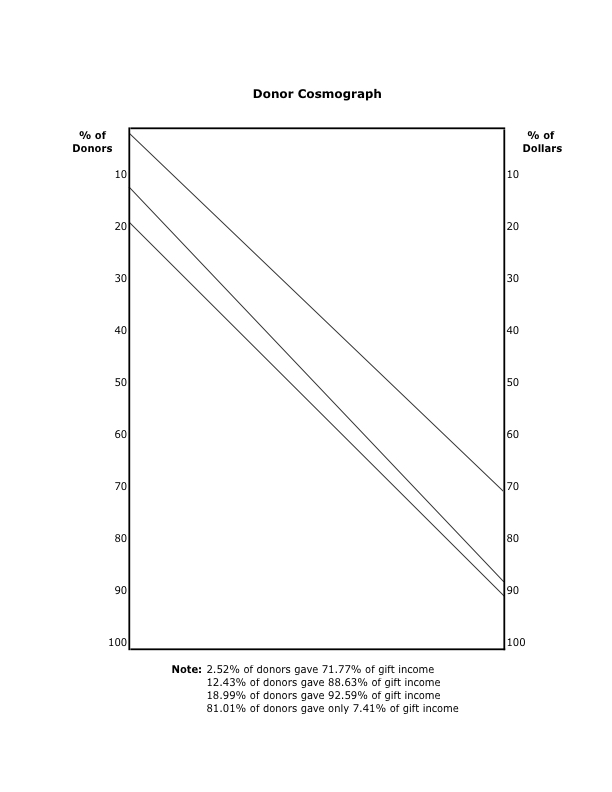Okay. It’s time for a personal confession.
I loathe waste. Inefficiency bothers me. And not being strategic just drives me up the wall.
It’s conceivably little more than some deeply ingrained idiosyncrasies, but I suspect the contributing factors may be a tad more complex. But whatever the ultimate constellation of causal variables, as a strategic thinker it just chafes my hide to see organizations stuck in the thick of thin things.
In fact, the apparently irresistible tendency of some organizations to major on the minor frequently brings to mind the immortal words of the late, great Fred Smith:
“The surest sign of God’s omnipotence is that he is going to win,
even though we’re on his side.”
As a development and strategic planning/management consultant, nowhere is this propensity to major on the minor more troubling than in the allocation of limited fundraising resources.
Lest you think my distress is only so much theoretical nitpicking, let me briefly recount the story of a new client a number of years ago in London. I’m sorry to say the organization is not a rare exception.
At the conclusion of a development seminar I had just conducted, I was approached by members of a fundraising team from a very prestigious organization with a request for help applying the segmentation concepts I had just shared. As a first step to assisting the organization with the segmentation of its donor base, I asked them for a cosmograph (see sample that follows, reflecting data from another client but with similar donor/dollar patterns). Since they were unfamiliar with this type of graph, I proceeded to explain the concept and how they could gather the necessary data.
———- § ———-
“Not only is it often the case that 20% of an organization’s donors provide 80% of the income,
it is not unusual for 5% of the donors to provide 50%, or 10% to provide 90% of the income.”
———- § ———-
I further explained how the Principle of the Critical Few (also known as the 80/20 Principle or Pareto Principle) – one of the most critical principles to anyone thinking strategically – often applies “in spades” to donor bases and smart fundraising. In fact, not only is it often the case that 20% of an organization’s donors provide 80% of the income, it is not unusual for 5% of the donors to provide 50%, or 10% to provide 90% of the income.
When organizational staff subsequently completed the necessary research and had constructed their cosmograph, to say they were chagrined would be a masterpiece of understatement. “Sheepish” might better describe their demeanor when we next met. The historic implications of their findings were nothing short of chilling.
Why? Because for three entire decades the organization had been allocating the bulk of its communications and fundraising resources to thousands of small donors who were having precious little if any real impact on the organization: roughly 90% of their donors who were providing only 10% of the organization’s gift income. (I fear that the thinking of some is, “Since there are more of them, they must be more important, right?”)
As a consequence, for an unbelievable span of 30 years they had chronically neglected the critical few donors (the 10% giving 90%) who were having a substantial impact on the organization and who also had the resources to do much more had they been adequately cared for.
With a smile I informed them that the French have a great word for those types of practices: “Stupide!”
Although their head-on collision with the truth of their cosmograph was jarring, I’m confident that this confrontation with their previously neglected data yielded an extremely valuable insight that continues to influence their fundraising focus and now more enlightened and strategic allocation of resources.
So, why is it critical to have a cosmograph inform your fundraising, and, more specifically, your segmentation practices?
- First, it’s a matter of stewardship. Your donors are investing in your work to make a difference. To see results. To see your mission advanced. To witness lives changed. And when the work of development staff is not informed by these unforgiving numbers, many donors’ gifts are often sadly and unnecessarily wasted. Rather than their gifts positively impacting programs and services, these funds are unwisely (and far too often unknowingly) consumed in largely fruitless communications to donors who have little potential to make a real difference in the organization’s work (e.g., the 81% of donors giving only 7% of gift income in the following chart).

Typically, as an unintended consequence, come planning and budgeting time the organization starts with “bottom-up” planning in their donor pyramid and, having exhausted the bulk of their budget on the inconsequential many rather than the critical few, ends up wrongly concluding that they lack the resources to focus at the top where they should have started: with major donors and major donor prospects. Often, if organizations would just heed the call of their cosmograph, they would see that they do indeed have the resources; they are just being misallocated – majoring on the minor many.
- Second, it’s a matter of strategy. Part of strategy and the leveraging of resources entails achieving the greatest possible impact with the least amount of resources, and this can’t be done when organizations indiscriminately and counter-strategically allocate resources, something that can happen quickly without the insights of a cosmograph, often with large segments of the typical donor base.
- Third, it’s just plain smart. Many years ago I learned one of fundraising’s greatest truths from the mining industry: “You’re either an inch from a million dollars or a million inches from a dollar.” Whether you’re into mining or fundraising, the principle holds: it always pays to know where you’re digging!
A formidable challenge you may be up against…
For many years with client organizations, I found a surprisingly powerful undercurrent of resistance to the notion of strategically allocating resources to areas of greatest fundraising potential: Egalitarianism. The idea that people (including donors) should be treated equally.
Don’t misunderstand. Equality is a noble notion. Downright American. But when it comes to successful fundraising, it’s a dumb idea. Dumb, but formidably tenacious.
Although I take comfort in my observations that this resistance has diminished substantially in recent years as intensifying competition has forced organizations to become more sophisticated, it clearly hasn’t disappeared completely. And trust me: the task of tackling deeply ingrained beliefs about treating donors equally so as to avoid preferential treatment should not be taken lightly, even in those contexts where these convictions are laudable but misplaced. And please don’t think that your task of subverting these convictions is a cakewalk just because you have compelling data to rationally make your case. Deeply held convictions and beliefs will almost always deflect dissonant and disconfirming data, even while adhering to these beliefs can depotentiate the performance of a good many organizations.
But setting aside the complexities and occasional difficulties involved, here’s your really simple choice when it comes to fundraising:
You can be egalitarian or you can be strategic.
You cannot simultaneously be both.
So what do I recommend? If you don’t have a cosmograph, let me encourage you to make it a priority. Pronto. The results could be a real wake-up call with significant dividends to your organization if heeded and consistently acted upon.
Once you’ve crunched the numbers and constructed your cosmograph, you’ve taken a critical step toward “turning the lights on” regarding segmentation and strategic fundraising, an eminently practical step toward setting the stage for better stewardship of limited resources and ultimately for greater impact on those you serve.
It’s only the first step of many you should take when it comes to segmentation, but without a doubt it’s a step in the right direction.
______________
For a complimentary copy of a spreadsheet used to construct a cosmograph, or for a complimentary consultation on your segmentation or other fundraising issues, email me at drlarryjohnston@aol.com, or call me at 303.638.1827. We’re here to help.
Larry Johnston, PhD is president of McConkey • Johnston International, a firm twice awarded “Best General Fundraising Counsel in the Christian Sector” in independent national surveys of development consulting firms.

